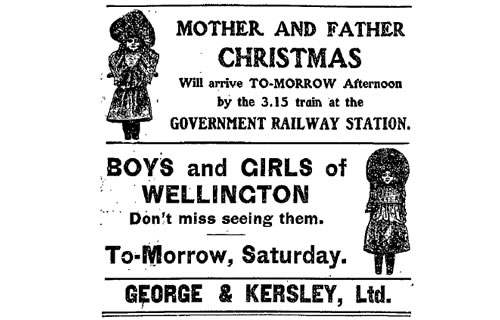Santa or Christmas parades take place throughout New Zealand in November and December each year. They began in the main centres in the early 20th century. They were established by department stores to promote the arrival of in-store Santas, with the aim of attracting customers.
George and Kersley Ltd’s Wellington store ‘the Economic’ appears to have been the first to ‘parade’ their Santa. In 1905 they invited local children to come to see ‘Mother and Father Christmas’ arrive at the railway station. The following year the pair stopped off in Hutt Valley and Petone en route to the store in Lambton Quay, whilst another character, Punch, visited suburbs and the hospital.
Over the next two decades Santas became a Christmas fixture at department stores, which sought more and more elaborate ways to promote their Santa’s arrival. The journeys by car and train that characterised early parades were dropped in favour of more exciting means of travel. During the 1930s Christchurch store Armstrong’s had Santa arrive on an elephant, while Farmers in Auckland and the DIC in Christchurch had their Santas arrive by plane (though he then had to travel by car to the store). In 1937 disaster was narrowly averted when Farmers outdid all previous efforts by having their Santa parachute onto Auckland Domain.
Santa’s entourage grew during this period. Fairies and giants were popular choices. In Farmers’ first ‘grand parade’ in Auckland in 1934, Santa was accompanied by the ‘Waggles and Goggles, The Fat Boy, The Man that Walks on his Hands, Harold Lloyd, the Giant and the Big Fiddle’. The following year local competitor George Court’s paraded Santa slongside ‘the Boop family of giants’.
The Second World War brought a temporary halt to the parades. By 1948 Farmers had reinstituted their Auckland parade, and Hay’s in Christchurch held their inaugural parade with a series of floats depicting ‘nursery rhymes and seasonal themes’.
The next few decades were a period of relative stability for Santa parades. Particular department stores came to dominate those held in the main centres – Farmers in Auckland, James Smith’s in Wellington and Hay’s in Christchurch.
Many of the elaborate floats created for these events still grace Santa parades today. And many of the traditions established during this period, such as Santa being preceded by a number of other acts, are hallmarks of the modern Santa parade.
By the late 1980s the parades were becoming too expensive for individual department stores to run. Between 1989 and 1991 the longstanding parades in Auckland, Wellington and Christchurch were taken over by charitable trusts. The parades became more overtly commercial as the trusts sold off the naming rights to both the entire parade and individual floats and characters. At the same time the parades became more representative of New Zealand society, with a broad range of community and voluntary groups participating alongside local businesses and traditional floats.
The parades were frequently criticised for being overly commercial. A number of councils considered stopping or cutting their funding, and directing it to more ‘community orientated’ events like Christmas in the Park. Wellington’s last large-scale Christmas parade was mounted in 2015. While many parades receive funding from councils and community trusts, they also rely heavily on commercial sponsors.




Community contributions